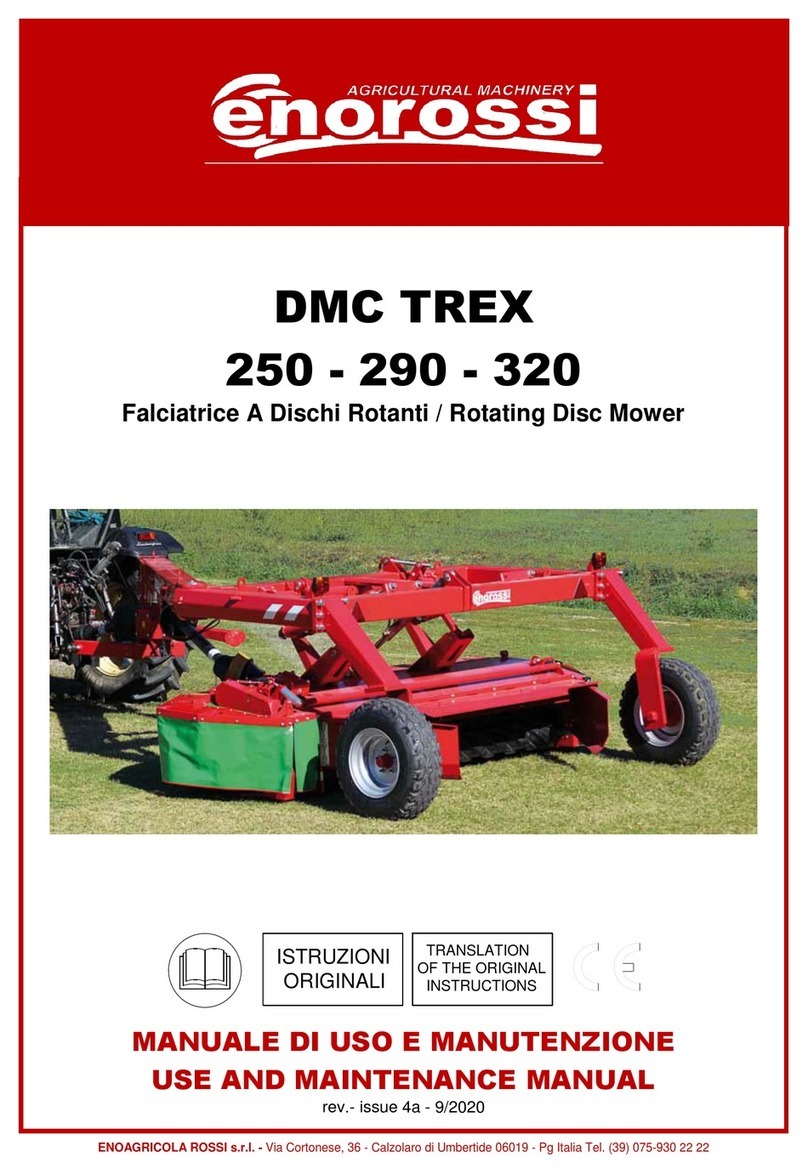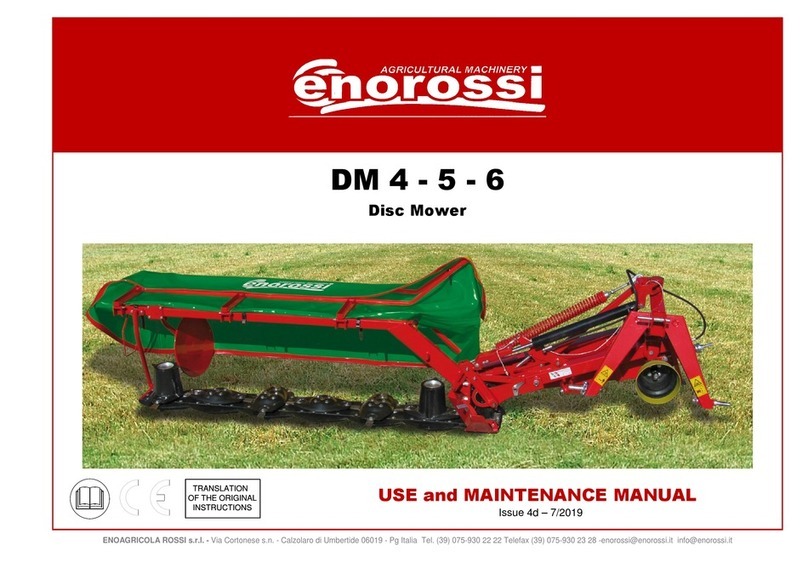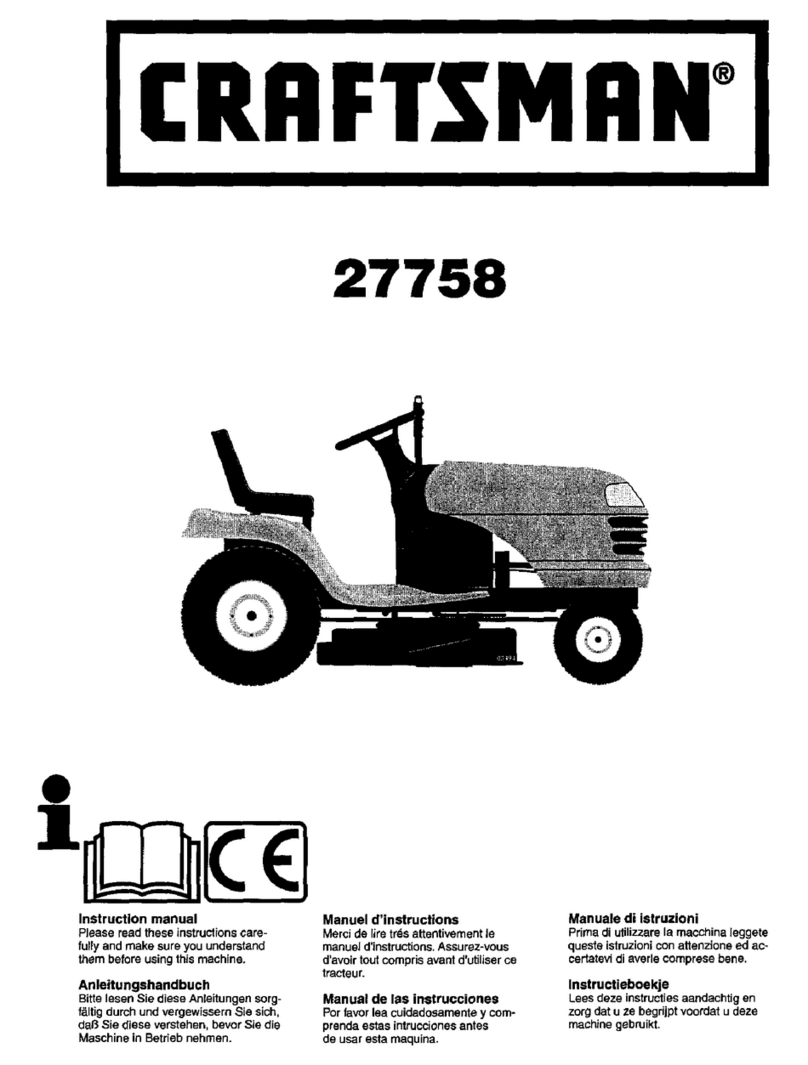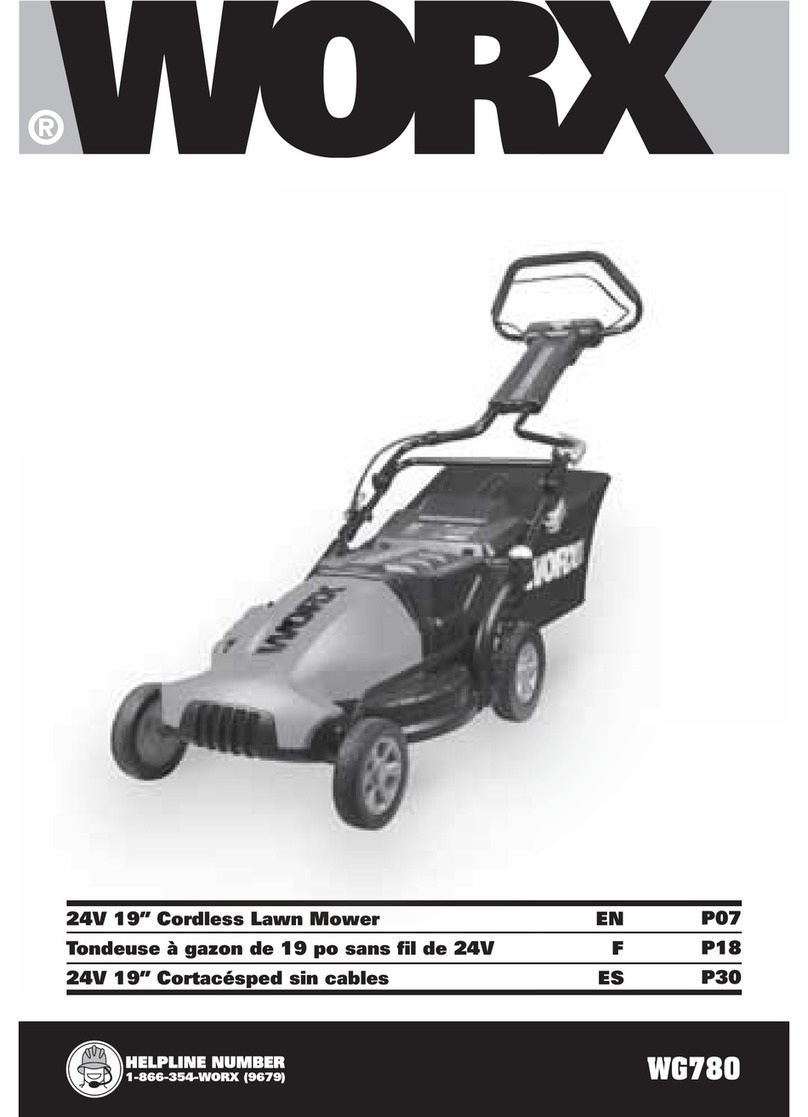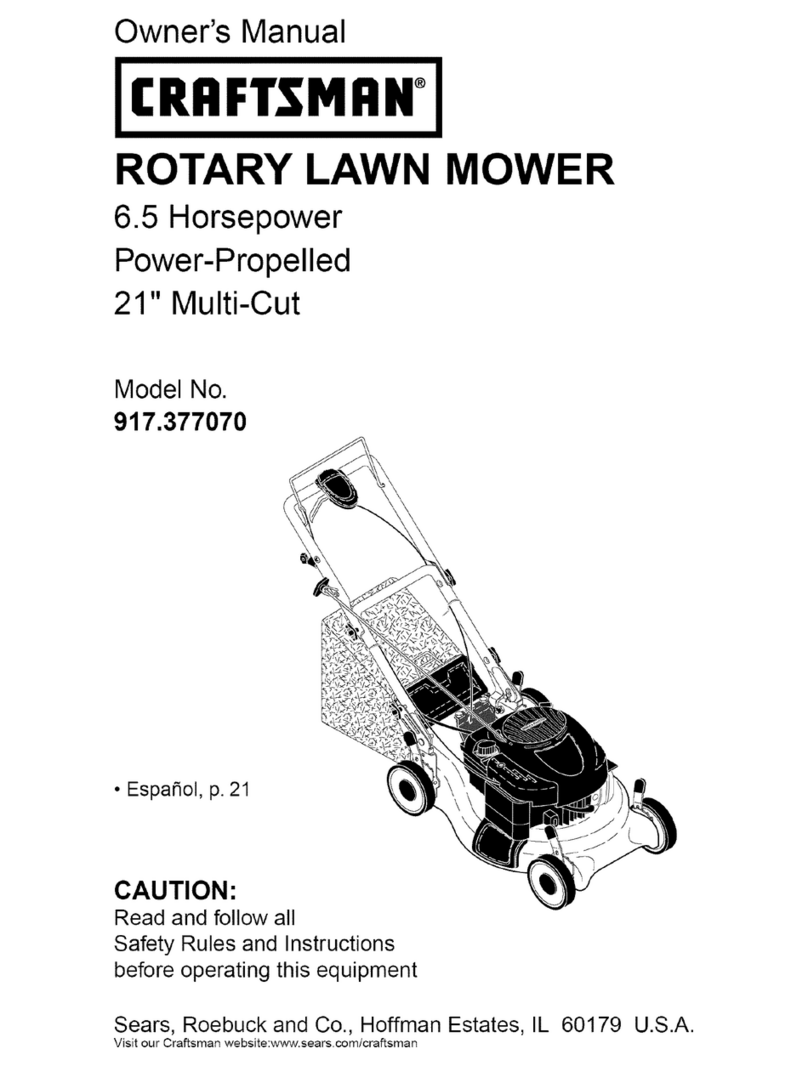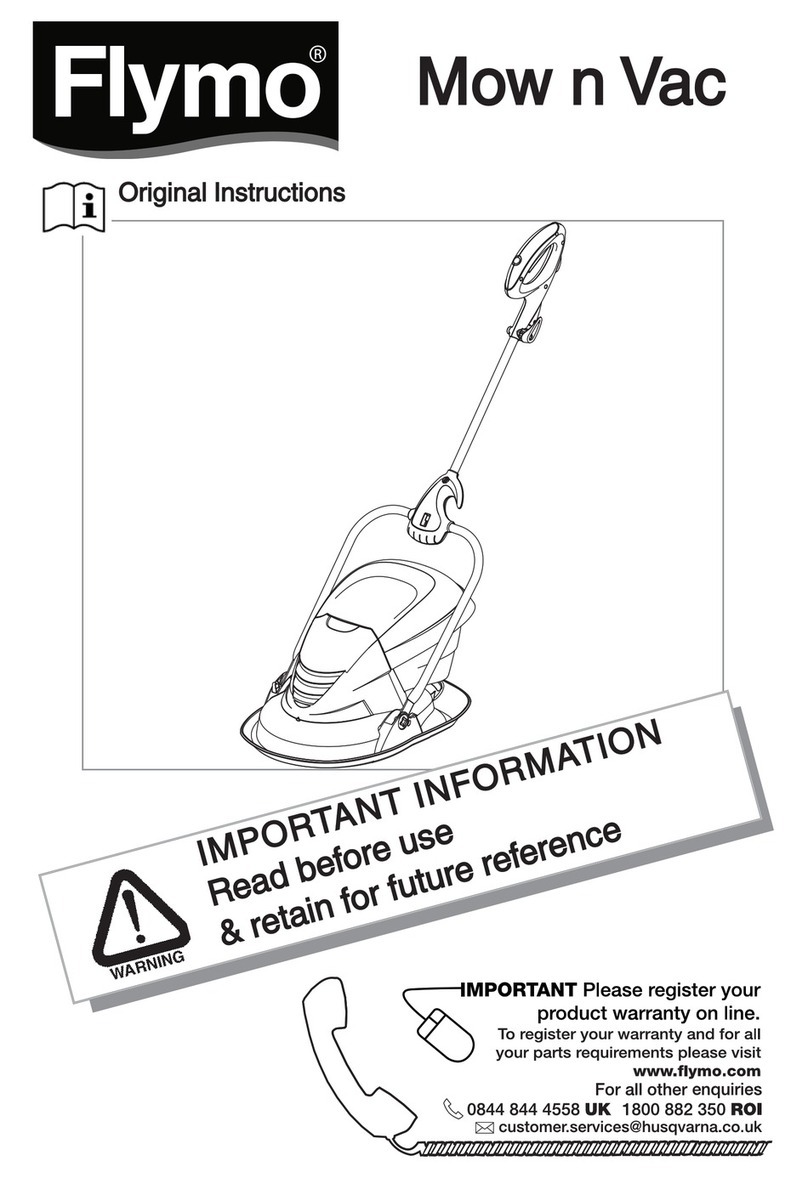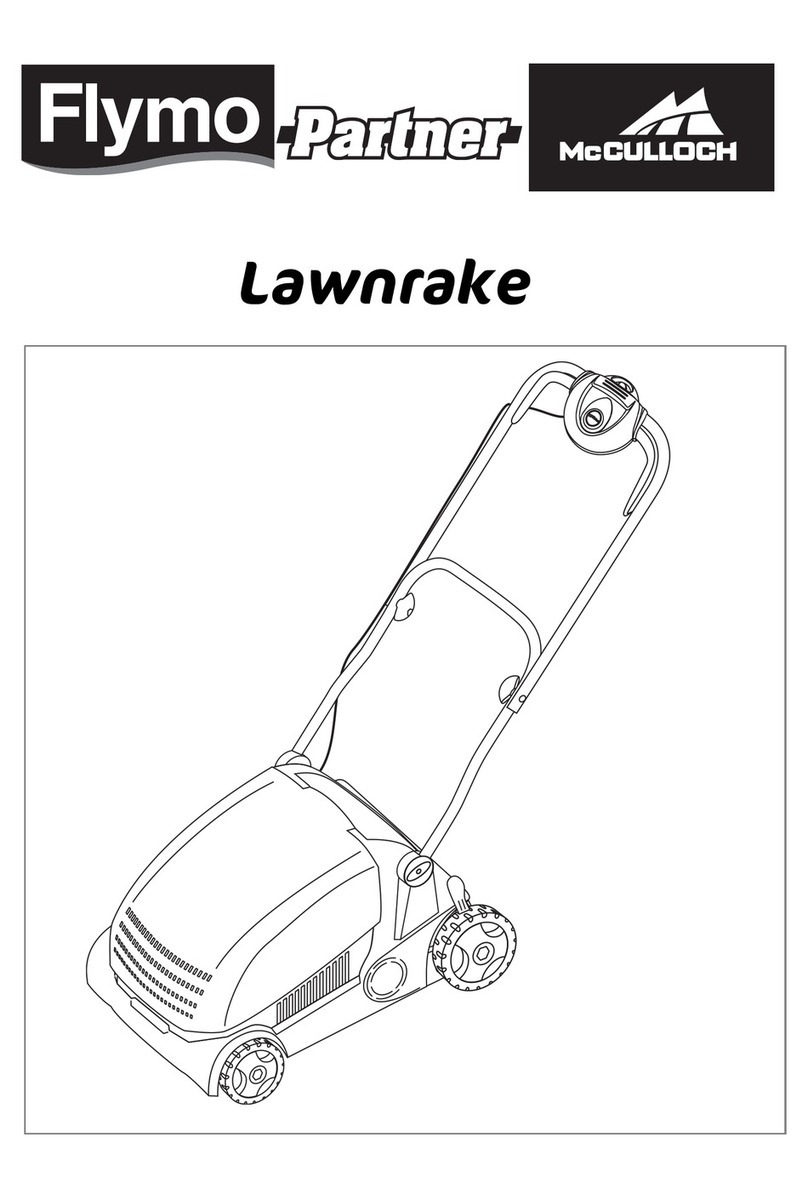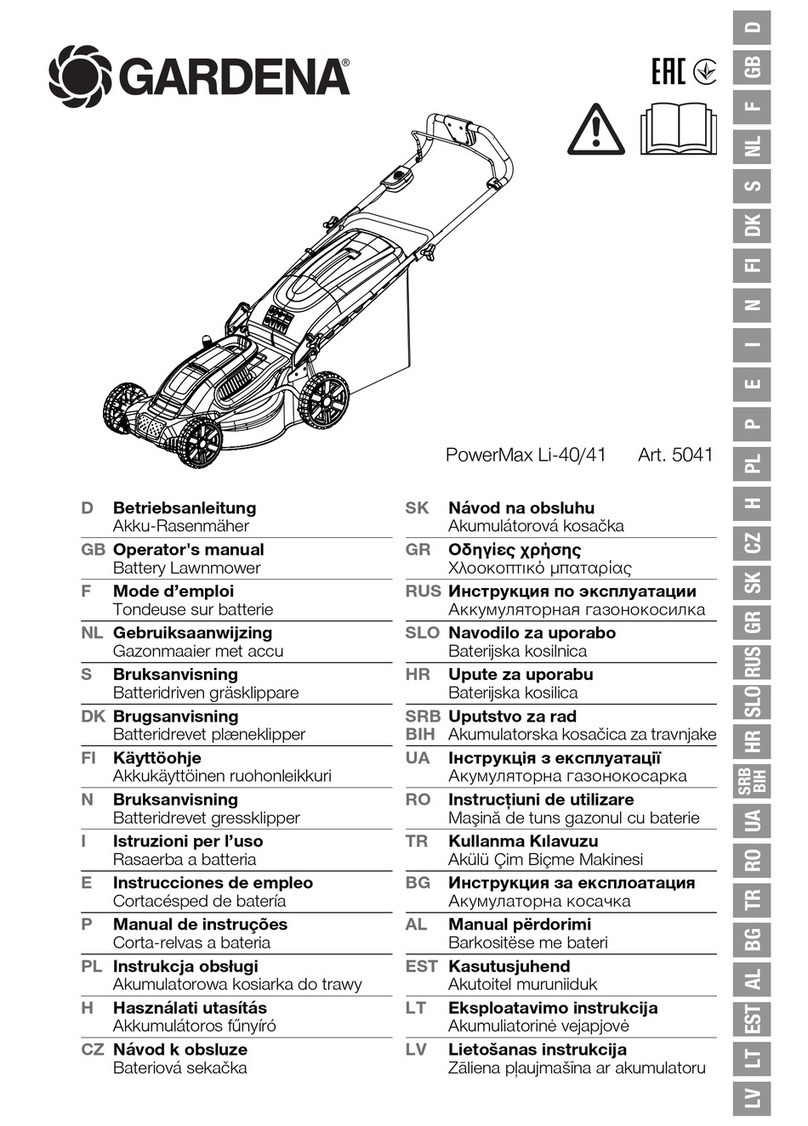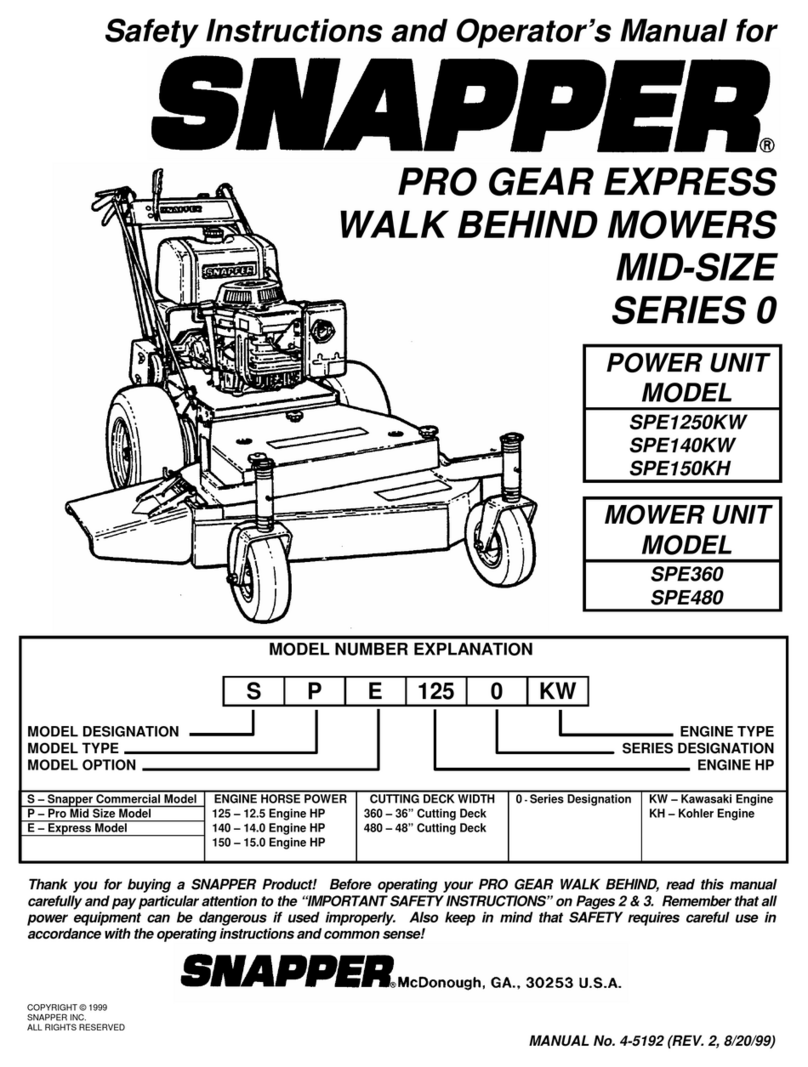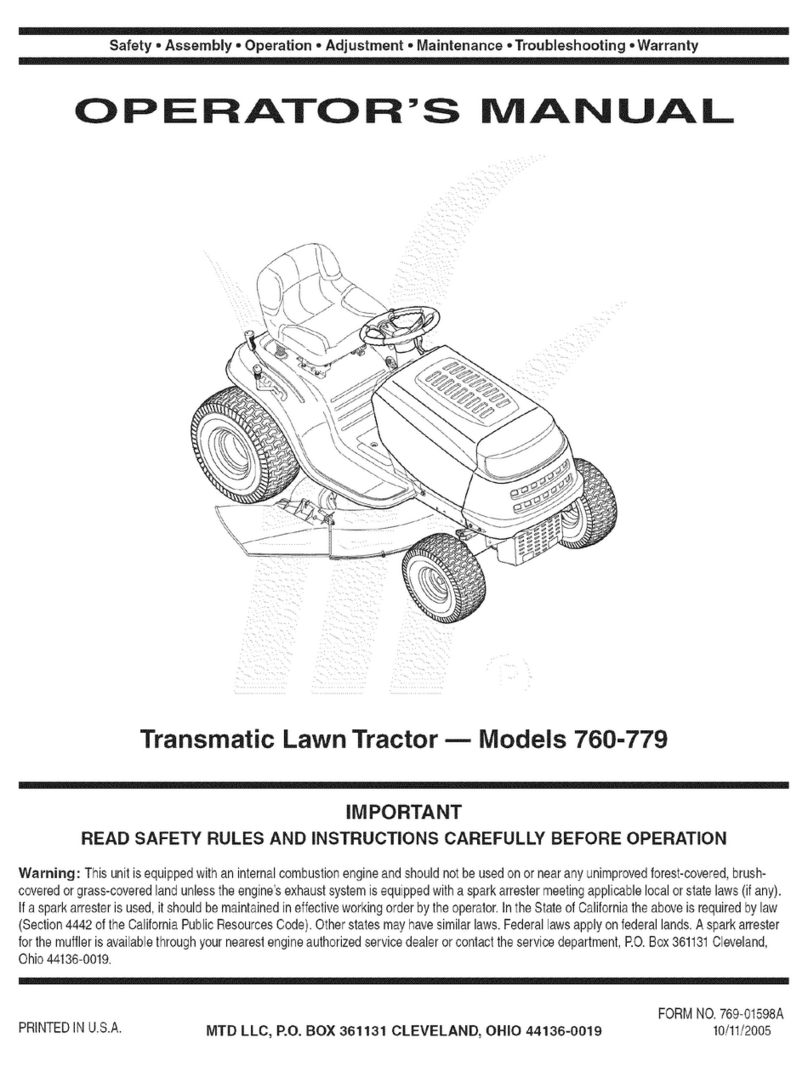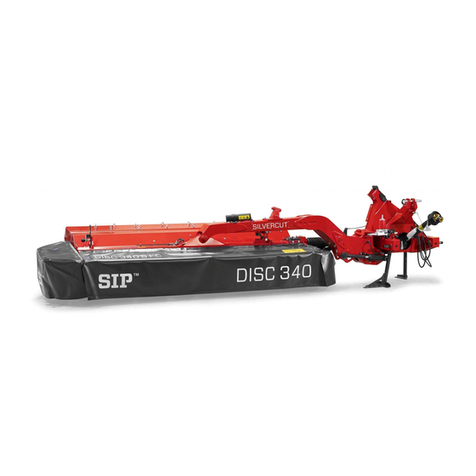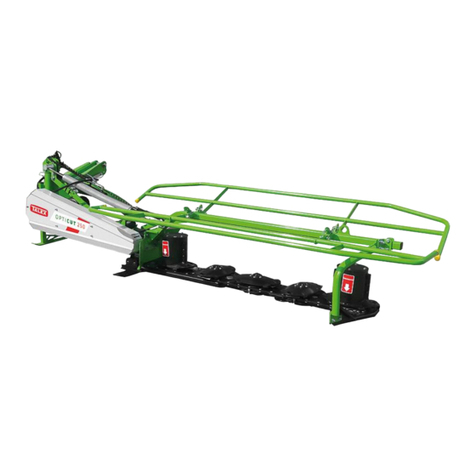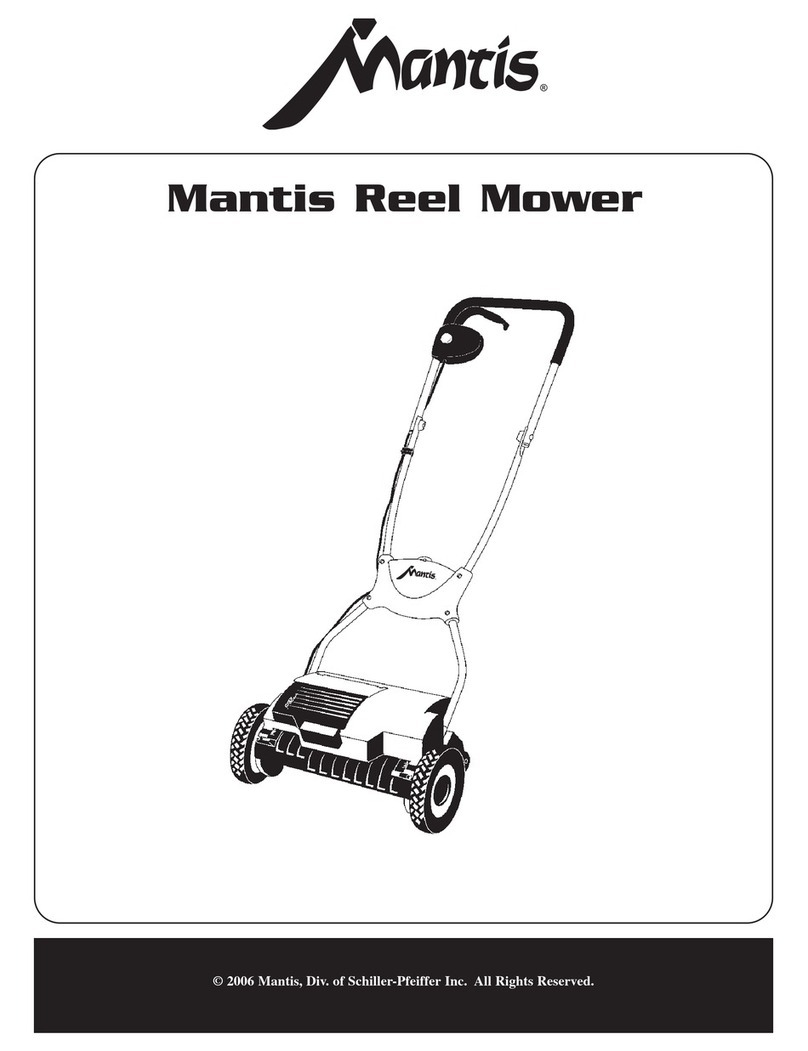enorossi BF User manual

ENOAGRICOLA ROSSI s.r.l.
Via Cortonese, 36 - Calzolaro di Umbertide 06019 - Pg Italia - Tel. (39) 075-930 22 22 Telefax (39) 075-930 23 28
BARRA FALCIANTE / SICKLE BAR MOWER
BF - BFS
MANUALE DI USO E MANUTENZIONE
USE AND MAINTENANCE MANUAL
rev.- issue 4a - 8/2020
ISTRUZIONI
ORIGINALI
TRANSLATION
OF THE ORIGINAL
INSTRUCTIONS

DICHIARAZIONE CE
DI CONFORMITÀ
(All.IIA Direttiva Macchine 2006/42/CE)
EC DECLARATION
OF CONFORMITY
(Annex IIA - Machinery Directives 2006/42/EC
Il Fabbricante ENOAGRICOLA ROSSI s.r.l.
con sede in via Cortonese, 36 - 06019
Calzolaro di Umbertide (PG) - Italia
dichiara sotto la propria responsabilità
che la macchina
The Manufacturer ENOAGRICOLA ROSSI s.r.l.
with head office in via Cortonese, 36 - 06019
Calzolaro di Umbertide (PG) - Italy
it declares under its own responsibility
that the machine
le cui funzioni sono descritte in questo manuale
è conforme ai requisiti essenziali
di Sicurezza e di Tutela della Salute di cui alla
Direttiva Macchine 2006/42/CE
Per la verifica della Conformità di cui alle Direttive
sopra menzionate, sono state consultate le seguenti
Norme Armonizzate EN:
whose functions are described in this manual
is conform to the Essential Requirements of
Safety and Health Protection, as per
Machinery Directive 2006/42/EC
To check the conformity of the Directives mentioned
up here, the following EN Harmonized Norms
have been consulted:
EN ISO 4254-1:2015 - EN ISO 4254-13:2010 - EN ISO 4413:2012
ISO 11684 (1995) - EN 12100:2010 - EN ISO 12965:2020 - EN ISO 13857:2020 - ISO 3600:2015
E autorizza Enorossi
Via Cortonese, 36 - 06019
Calzolaro di Umbertide (PG) - Italia
a costituire il Fascicolo Tecnico per suo conto
and it authorizes Enorossi
Via Cortonese, 36 - 06019
Calzolaro di Umbertide (PG) - Italia
to compile the relevant technical documentation
GIOVANNINI ADELMO
Calzolaro di Umbertide, …….. ……. …… ….……………………….
Legale rappresentante - Legal representative
BARRA FALCIANTE - SICKLE BAR MOWER
……………………………………………………………………………………….…………………………………..
Denominazione generica e commerciale –Generic denomination and commercial name
BF ...
…………………………..
Serie/Modello - Series/Model
….
……………………………………………
Matricola - Serial number
20..
…………….
Anno costruzione
Manufacturing year

3
INDICE - INDEX
DICHIARAZIONE CE DI CONFORMITÀ
2
EC DECLARATION OF CONFORMITY
2
INTRODUZIONE
5
INTRODUCTION
5
INFORMAZIONI SUL MANUALE
5
INFORMATION ABOUT THE MANUAL
5
IDENTIFICAZIONE E CERTIFICAZIONI CE
6
IDENTIFICATION AND EC CERTIFICATION
6
COMPONENTI PRINCIPALI E DATI TECNICI
7
MAIN COMPONENTS AND TECHNICAL DATA
7
GARANZIA
8
WARRANTY
8
SICUREZZA
10
SAFETY
10
NORME GENERALI
10
GENERAL RULES
10
SICUREZZE CIRCA IL TRASPORTO, L’INSTALLAZIONE
E GLI SPOSTAMENTI
10
SAFETY ABOUT THE TRANSPORT, THE
INSTALLATION AND THE MOVEMENTS
10
USO PREVISTO E AVVERTENZE NELL’IMPIEGO
13
INTENDED USE AND WARNING OF EMPLOY
13
USO SCORRETTO RAGIONEVOLMENTE PREVEDIBILE
E LIMITI D’IMPIEGO
16
REASONABLY FORESEEABLE MISUSE AND LIMIT OF
EMPLOY
16
RESPONSABILITÀ DELL’OPERATORE
17
RESPONSIBILITY OF THE OPERATOR
17
PITTOGRAMMI
17
PICTOGRAMS
17
RUMOROSITÀ
19
NOISINESS
19
RISCHI RESIDUI
19
RESIDUAL RISKS
19
INSTALLAZIONE
20
INSTALLATION
20
INFORMAZIONI PRELIMINARI
20
PRELIMINARY INFORMATIONS
20
INSTALLAZIONE AL TRATTORE E CONFIGURAZIONE
DA LAVORO
20
INSTALLATION TO THE TRACTOR AND WORKING
CONFIGURATION
20
INSTALLAZIONE ALBERO CARDANICO
23
INSTALLATION OF CARDAN SHAFT
23
RIMOZIONE
23
REMOVAL
23
IMMAGAZZINAMENTO DELLA BARRA FALCIANTE
23
STORAGE OF THE DISC MOWER
23
FUNZIONAMENTO ED USO
24
OPERATION AND USE
24
INFORMAZIONI PRELIMINARI
24
PRELIMINARY INFORMATIONS
24
MESSA IN SERVIZIO (CONFIGURAZIONE DA LAVORO)
24
ACTIVATION (WORKING CONFIGURATION)
24
USO
25
USE
25
REGOLAZIONE DELL’ALTEZZA DI TAGLIO
27
ADJUSTMENT OF THE CUTTING HEIGHT
27
REGOLAZIONE VELOCITA ABBASSAMENTO/
SOLLEVAMENTO DELLA BARRA DI TAGLIO
27
ADJUSTMENT OF THE LOWERING / LIFTING SPEED
OF THE CUTTING BAR
27
CONTROLLO E REGOLAZIONE TENSIONE CINGHIE DI
TRASMISSIONE
28
CHECK AND ADJUSTMENT OF THE BELT TENSION
28
TERMINE LAVORO
29
END OF WORKING PROCESS
29
MANUTENZIONE
30
MAINTENANCE
30
AVVERTENZE IN FASE DI MANUTENZIONE
30
MAINTENANCE WARNINGS
30
INTERVENTI DI MANUTENZIONE
31
MAINTENANCE PROCEDURES
31
LUBRIFICAZIONE
37
LUBRICATION
37
RICERCA GUASTI
37
TROUBLESHOOTING
37
SMALTIMENTO MATERIALI IN CASO DI DEMOLIZIONE
37
MATERIALS DISPOSAL IN CASE OF SCRAPPING
37

4
Direttiva Macchine e Norme armonizzate
Le barre falcianti BF/BFS sono state progettate seguendo
le norme descritte nella Direttiva Macchine 2006/42CE ed
in particolare soddisfano le seguenti Norme armonizzate:
EN ISO 4254-1:2015Macchine agricole - Macchine
agricole semoventi, portate, semiportate e trainate -
Requisiti comuni di sicurezza
EN ISO 4254-13:2012Macchine agricole - Macchine
agricole semoventi, portate, semiportate e trainate -
Sicurezza - Parte 13: Falciatrici e trinciatrici
EN ISO 4413:2010 Oleoidraulica - Regole generali e
requisiti di sicurezza per i sistemi e i loro componenti.
ISO 11684: Trattrici, macchine agricole e forestali,
macchine a motore da giardinaggio - Segni grafici per la
sicurezza e pittogrammi di segnalazione dei pericoli -
Principi generali (1995)
EN 12100:2010 Sicurezza del macchinario - Principi
generali di progettazione - Valutazione del rischio e
riduzione del rischio
EN 12965:2020 Trattori e macchine per l'agricoltura e la
silvicoltura. Presa di forza (PTO), alberi di trasmissione e
le loro guardie. Sicurezza
EN 13857:2020 Sicurezza del macchinario - Distanze di
sicurezza per impedire il raggiungimento di zone pericolose
con gli arti inferiori
ISO 3600:2015 Trattrici e macchine agricole e forestali,
attrezzature per prato e giardino dotate di motore -
Contenuto e presentazione
Machinery Directive and Harmonised standards
The BF/BFS mowers have been designed in accordance
with the norms described in the Machinery Directive
2006/42/EC and particularly it satisfies the following
Harmonized norms:
EN 4254-1:2015 Agricultural machinery - Self-propelled,
mounted, semi-mounted and trailed machines - Common
safety requirements
EN ISO 4254-13:2012 Agricultural machinery - Safety -
Part 13: Large rotary mowers
EN ISO 4413:2010 Hydraulic fluid power - General rules
and safety requirements for systems and their components.
ISO 11684: Tractors, machinery for agriculture and
forestry, powered lawn and garden equipment - Safety
signs and hazard pictograms - General principles (1995)
EN ISO 12100-2010: Safety of machinery - General
principles for design - Risk assessment and risk reduction
EN 12965:2020 Tractors and machinery for agriculture and
forestry. Power take-off (PTO) drive shafts and their
guards. Safety
EN 13857:2020 Safety of machinery - Safety distances to
prevent hazard zones being reached by upper and lower
limbs
ISO 3600:2015 Tractors, machinery for agriculture and
forestry, powered lawn and garden equipment - Operator's
manuals - Content and format

5
INTRODUZIONE
Informazioni sul manuale
La ditta ENOROSSI (di seguito denominata
“Fabbricante”) ha progettato e realizzato l’attrezzatura
nel rispetto di appropriate norme di sicurezza con il
preciso intento di salvaguardare sia il personale che vi
opera intorno che l’intero sistema operativo.
Ogni barra falciante viene fornita di una copia di questo
manuale, che deve essere letto attentamente prima che
la stessa venga utilizzata. Nel manuale sono contenute
le informazioni necessarie per il trasporto, l’impiego e la
manutenzione dell’attrezzatura nonché le relative
norme di sicurezza.
La mancata conoscenza del suo sistema operativo
potrebbe provocare incidenti, con conseguenti danni
alla stessa attrezzatura. Pertanto, anche se al momento
della consegna il Fabbricante fornisce al Cliente tutte le
informazioni relative alla barra falciante (funzionamento,
uso e manutenzione), questi è tenuto, comunque, a
leggere il presente manuale e ad osservare le istruzioni
in esso contenute.
Il manuale fornisce le indicazioni di base per ottenere le
migliori condizioni di lavoro e di sicurezza ma resta
comunque l'esperienza ed il buon senso dell'operatore
il fattore più importante per il funzionamento
dell’attrezzatura. La stesura del manuale è stata
eseguita in base alle caratteristiche tecniche e
costruttive degli attuali modelli di barra falciante e non
tiene conto dei modelli simili prodotti in precedenza.
Tuttavia, il Fabbricante si riserva il diritto di apportare
modifiche ai modelli in produzione, al fine di migliorarne
il prodotto o qualora venissero emanate nuove
disposizioni in materia (Direttiva Macchine), senza
l’obbligo di adeguare i modelli costruiti in precedenza.
Il presente manuale costituisce parte integrante della
barra falciante e, perciò, deve essere bene conservato,
pulito ed integro in tutte le sue parti e custodito in un
apposito contenitore, posto sul telaio dell’attrezzatura o
all’interno della cabina del trattore, pronto per ogni
consultazione.
In caso di cessione della barra falciante sarà importante
verificare che il manuale sia presente nella sua
custodia. Nel caso esso fosse andato disperso, sarà
necessario chiederne un duplicato al Fabbricante.
Se durante la lettura del manuale le istruzioni
risultassero incomprensibili, è opportuno contattare il
Fabbricante, che fornirà gli opportuni chiarimenti.
Qualora il manuale fosse tradotto in un’altra lingua e
parte del suo contenuto dovesse dare adito a
controversie, il testo valido di riferimento rimane quello
scritto in lingua italiana.
Segnalazioni contenute nel manuale:
INTRODUCTION
Information about the manual
The ENOROSSI Company (hereafter called
Manufacturer) has designed and built the disc mower in
obedience to appropriate safety regulations in order to
protect both the operators which work with the
equipment and its operating system.
Each mower is supplied by a copy of this manual, which
should be carefully read before using the equipment.
The manual contains the necessary information about
the transport, use and maintenance of the equipment,
as well as relevant safety rules.
Lack of knowledge about its operating system may
cause accidents with damage to the operator and to the
equipment itself.
Therefore, even if the Manufacturer, after the machine
delivery, provides all the information concerning the
mower (operation, use and maintenance) the Customer
has to read all manuals and to observe the contained
instructions.
The manual furnishes the basic indications to obtain the
best work and safety conditions but the experience and
the good sense of the operator remain the most
important factor for the mower operation.
The manual is updated to the characteristics of the disc
mower and does not relate to earlier models.
Nevertheless the Manufacturer reserves the right to
modify the manual if new regulations were issued
(Machine Directive) in the subject of technical content
or only to improve comprehension without obligation to
update the machines and preceding manuals.
This manual is integral part of the equipment and
consequently it must be carefully preserved,
undamaged in all parts of it and kept in a folder (placed
on the equipment chassis), ready for consultation.
In case the mower was sold or transferred to other user,
it is important to ensure that the manual is in its folder.
In case this has gone missing, it will be necessary to
ask the Manufacturer for a duplicate.
If during the reading of the manual some instructions
result incomprehensible, it is advisable to contact the
Manufacturer (whose telephone numbers and fax are
printed on the cover) who will provide the relative
explanation.
If the manual has been translated into another language
and part of its contents gives rise to controversy, the
valid text of reference remains the one written in
language Italian.
Indications contained in the manual:

6
IMPORTANTE
Per segnalare che le informazioni riportate devono
essere assolutamente conosciute dall’operatore.
ATTENZIONE
Per segnalare una probabile situazione di pericolo
che riguarda l’incolumità dell’operatore ed altrui
(lievi infortuni o ferite) o che riguarda l’efficienza
della barra falciante.
PERICOLO
Per segnalare una reale situazione di pericolo che
riguarda l’incolumità dell’operatore ed altrui (gravi
infortuni fino a rischio di morte) o che riguarda
l’efficienza della barra falciante.
La scritta Nota indica che l’argomento trattato può
agevolare il lavoro svolto dall’operatore.
Identificazione e certificazioni CE
Ogni attrezzatura è dotata
di una targhetta d’iden-
tificazione, applicata sul
telaio e bene in vista, su cui
sono riportati i seguenti dati:
-il modello (e/o
versione);
-il numero di matricola;
-l’anno di costruzione.
Tali dati dovranno essere
citati per ogni necessità di
assistenza e di ricambi.
IMPORTANTE
È assolutamente vietato alterare e/o cancellare i dati
riportati sulla targhetta d’identificazione. Ad ogni modo,
l’operatore è tenuto a verificare spesso la leggibilità dei
dati e, quando questa risulterà precaria, a comunicarlo
al Fabbricante. Questi provvederà a riportare i dati su
una nuova targhetta e a sostituire quella precedente.
Il marchio CE indica che il Fabbricante si è adeguato
alle disposizioni che gli Stati membri della Comunità
Europea hanno adottato sulla sicurezza e sulla salute in
materia e che è nota come “Direttiva macchine”.
Ciò significa che il Fabbricante ha progettato e costruito
l’attrezzatura nel pieno rispetto di tutti i requisiti richiesti
per il suo utilizzo e per evitare tutti i possibili rischi e
pericoli derivanti. Pertanto, la barra falciante può
circolare liberamente nel territorio europeo solo se
munita di questo marchio e della relativa dichiarazione
di conformità.
IMPORTANT
It indicates that the information must absolutely be
known by the operator.
WARNING
Indicates a potentially hazardous situation that, if not
avoided, could result in death or
serious injury. It is
also used to alert against unsafe practices.
HAZARD
It indicates an actual situation of danger for the
operator and for others (serious accidents
including risk of death) or concerning the reliability
of the equipment.
The writing NOTE indicates that the treated matter can
make it easier for the operator to carry out the job.
EC Identification and certification
On every mower an
identification plate is
applied, well in sight, on
which punched other than
the Manufacturer data, also:
-model (and/or version);
-serial number;
-manufacturing year.
Such data is necessary for
technical assistance and for
spares.
IMPORTANT
It is absolutely forbidden to alter and/or erase the data
written on the identification plate of the equipment. The
operator is required to verify frequently the legibility of
the data and, when this in doubt, to communicate with
the Manufacturer. The data will be transferred to a new
plate to replace the old one.
The CE mark certifies that the Manufacturer has
complied with regulations in force governing machinery
and covering health and safety matters as specified for
all EU Member states (Machinery Directive).
In practical terms, the CE mark guarantees that the
Manufacturer has designed and constructed the
machine in such a way as to avoid and minimize risk
and danger, in anticipation of the function and the
conditions under which the equipment will be used. The
equipment may be used in Europe only if it is equipped
with the identification plate and provided with the
declaration of conformity.
Type: XXXXXXXX Model
Serial N. XXXXXXX-XX
MFG: 2015 DEL: 2015
Enoagricola Rossi S.R.L.
Calzolaro di Umbertide - Perugia
Made in Italy

7
Componenti principali e dati tecnici
1. Telaio
2. Punto di attacco superiore
3. Punto di attacco inferiore
4. Snodo telaio
5. Piede di sostegno
6. Carter di protezione
7. Scarpa esterna
8. Bandella laterale
9. Barra di taglio
10. Tirante di aggancio
11. Molla ammortizzatrice
12. Tirante di regolazione molla ammortizzatrice
13. Catena regolazione altezza operativa
14. Catena regolazione per cavo di sollevamento
(escluso modelli BFS 240 H e BFS 270 H)
15. Cavo di sollevamento barra
(escluso modelli BFS 240 H e BFS 270 H)
16. Protezione lama e scarpa barra
17. Slitta
Main components and Technical data
1. Chassis
2. Upper 3-point hitch linkage
3. Lower 3-point hitch linkage
4. Chassis articulation
5. Bearing foot
6. Protection guard
7. External shoe
8. Lateral deflector
9. Cutting bar
10. Blade attachment rod
11. Compensation spring
12. Compensation spring adjustment rod
13. Operating height adjustment chain
14. Lifting cable adjustment chain
(except BFS 240 H and BFS 270 H models)
15. Blade lifting cable
(except BFS 240 H and BFS 270 H models)
16. Blade protection and external shoe
17. Skid
CARATTERISTICHE TECNICHE
TECHNICAL DATA
BF
180 M/H
BF
210 M/H
BFS
165 M/H
BFS
180 M/H
BFS
210 M/H
BFS
240 H
BFS
270 H
Larghezza di lavoro - Working width
cm / ft
180 / 6
210 / 7
165 / 5.5
180 / 6
210 / 7
240 / 8
270 / 9
Velocità di lavoro - Working speed
Km/h
15
15
15
15
15
15
15
Potenza trattore - Tractor power
Hp
25
25
25
25
25
40
40
Presa di forza - Power take-off
rpm
540
540
540
540
540
540
540
Peso - Weight
Kg/lbs
261 / 576
272 / 600
263 / 581
271 / 598
287 / 634
305 / 673
322 / 711

8
Garanzia
La ditta Enorossi (denominata Fabbricante)
garantisce che la barra falciante è esente da difetti in
ogni suo componente, in quanto la sottopone a
collaudo prima di consegnarla al Cliente. La
garanzia ha validità 1 anno a partire dalla data
indicata nel documento fiscale di consegna,
salvo diversi accordi sottoscritti con il Cliente.
Ad ogni modo, questi, al ricevimento della barra
falciante, deve verificare che la stessa sia integra e
completa in ogni sua parte. Eventuali reclami
dovranno pervenire al Fabbricante, per iscritto, entro
8 giorni dal ricevimento dell’attrezzatura.
Entro il periodo di garanzia la ditta Enorossi si
impegna a sostituire, gratuitamente e presso la sua
sede, i componenti che, per difetti di fabbricazione o
di materiale, danno vita ad avarie di funzionamento.
Qualora non fosse possibile effettuare tale
sostituzione presso la propria sede, il Fabbricante si
impegna ad inviare, presso la sede del Cliente i pezzi
risultanti difettosi. In merito a tali sostituzioni, la ditta
Enorossi non proroga il periodo di garanzia per il
tempo durante il quale la barra falciante rimane
ferma, né riconosce alcun risarcimento o indennizzo
al Cliente, per spese o per danni diretti o indiretti.
Qualora fosse necessario l’intervento di un nostro
tecnico, le relative spese di manodopera, viaggio e
soggiorno saranno interamente a carico del Cliente.
L’accertamento del difetto può essere effettuato
esclusivamente dal Fabbricante o da personale
tecnico incaricato dallo stesso.
Tuttavia è bene tenere presente che:
-i pezzi difettosi restano di proprietà del
Fabbricante;
-qualora la sostituzione venisse effettuata presso
la sede del Cliente, i pezzi difettosi dovranno
essere restituiti e, quindi, inviati al Fabbricante,
per essere sottoposti ad esame tecnico, integri,
senza manomissioni ed in porto franco;
-nel caso in cui i pezzi difettosi non fossero
restituiti al Fabbricante entro 30 giorni, dalla data
di ricezione di quelli nuovi e con le modalità
descritte nel punto precedente, il Fabbricante si
riserva il diritto di provvedere alla fatturazione dei
pezzi nuovi inviati.
La garanzia non viene riconosciuta:
-durante il trasporto in quanto la barra falciante
viaggia sotto la responsabilità del Cliente;
-quando i guasti sono derivanti da un uso
improprio o scorretto della barra falciante o dalla
negligenza dell’operatore;
-quando i guasti sono causati da normale usura
anche con la barra falciante non in esercizio;
Warranty
The Enorossi company (Manufacturer) guarantees
that the mower is exempt from defects in any kind
since it has been submitted to testing before its
delivery to the Customer. The warranty has a one-
year validity starting from the indicated date on
the fiscal document of delivery, unless different
agreements signed with the Customer.
In any case, when the Customer receives the
equipment, he must check its condition and
completeness in all parts. Eventual complaints should
be notified to the Manufacturer in written form within
8 (eight) days of reception of the disc mower.
Within the warranty period the Manufacturer
undertakes to replace, without charge and at it
factory, any parts damaged in manufacture or
through defective material. Should it not be possible
to replace the parts in it factory, the Manufacturer will
send the required parts to the Customer.
Regarding to these replacements, the Enorossi
company will not extend the warranty to cover the
period during which the equipment remains out of
service neither he will consider any compensation or
indemnity to the Customer for costs or damages
(directly or indirectly). If the assistance of a member
of our staff is required all his expenses will be paid by
the Customer.
The investigation of defects can only be carried out
by the Manufacturer or by authorised technical
personnel.
However it is necessary to remember that:
-defective parts will remain property of the
Manufacturer;
-in the case that replacement is performed on the
Customer’s premises, the defective parts must
be sent back to the Manufacturer, intact, without
breakage and without any transport charge to
the Manufacturer;
-in the case that the defective parts are not
returned to the Manufacturer within 30 (thirty)
days (from the date of receipt of the new ones
and in accordance with the terms described
above), the Enorossi company reserves the right
to invoice the new parts sent.
The warranty is not recognized:
-during transport, as the mower travels under the
responsibility of the Customer;
-if the failures are caused by an improper or
incorrect use of the mower, by the carelessness
or lack of experience of the operator;
-if the failures are caused by normal wear and
tear even if the mower is out of service;

9
-in caso di tardiva segnalazione di difetti di
costruzione;
-nel caso di incidenti o in casi fortuiti di forza
maggiore.
La garanzia decade qualora:
-la barra falciante venga usata da personale non
adeguatamente addestrato;
-non siano state eseguite o rispettate le
indicazioni e/o le norme descritte in queste
istruzioni;
-non siano stati eseguiti i previsti interventi di
manutenzione;
-il Cliente apporti delle modifiche alla barra
falciante senza l’autorizzazione scritta del
Fabbricante o che lo stesso effettui mano-
missioni su componenti;
-siano utilizzati ricambi non originali o non
conformi a quelli consigliati dal Fabbricante.
Ad ogni modo, il periodo di garanzia riconosciuto per
la barra falciante non è valido per tutti i componenti
non prodotti dal Fabbricante e per i quali resta valido
quello riportato nelle rispettive note di acquisto.
IMPORTANTE
Il Fabbricante non garantisce la conformità della
barra falciante alle disposizioni di legge vigenti ed in
particolare a quelle relative alla prevenzione degli
infortuni ed all’inquinamento nei paesi extra U.E.
L’adeguamento della barra falciante alle rispettive
norme sarà interamente a carico e sotto la
responsabilità del Cliente. Il Fabbricante è sollevato
da ogni responsabilità se l’inosservanza delle norme
stesse dovesse dare atto a controversie o provocare
qualsiasi tipo di danno.
-in case of a delay in notifying a defective part due
to manufacture;
-in the case of accident or act of God.
The warranty does not apply if:
-the equipment is used by personnel inadequately
trained;
-the instructions and rules contained in this
manual are not followed;
-the prescribed maintenance tasks are not
performed;
-the Customer modifies the equipment without the
written authorisation of the Manufacturer or when
the Customer effects tampers with components;
-spare parts other than those supplied or
recommended by the Manufacturer are used.
The normal warranty period for the mower is not valid
for all components not made by the Manufacturer
which are covered by the policy mentioned in the
appropriate manual.
IMPORTANT
The Manufacturer does not guarantee the conformity
of the equipments to regulations in force in the
countries outside the European Union, in particularly
to those related to the prevention of accidents and to
pollution. Adjustment of the machine to comply with
these regulations will be entirely expense and
responsibility of the Customer. The Manufacturer is
absolved from all responsibility if non-observance of
the regulations creates legal problems or gives rise to
any damage whatsoever.

10
SICUREZZA
Norme generali
In questo manuale sono descritte le norme di
sicurezza da osservare nell’impiego della barra
falciante. Poiché la maggior parte degli incidenti sul
lavoro si verificano perché non vengono rispettate le
più elementari norme di sicurezza, è obbligatorio,
prima di attivare qualsiasi funzione, leggere questo
manuale e seguire scrupolosamente le istruzioni in
esso contenute.
L’utilizzo dell’attrezzatura deve essere affidato a
personale maggiorenne, qualificato ed addestrato per
il suo impiego. Il Fabbricante, pertanto, non
risponde di incidenti causati dalla negligenza
dell’operatore e/o dall’inosservanza delle norme
di sicurezza. Inoltre si annullerebbero imme-
diatamente sia la responsabilità del Fabbricante
che la garanzia della barra falciante.
Sicurezze circa il trasporto, l’installazione e gli
spostamenti
Trasporto (consegna): l’attrezzatura viaggia parzial-
mente smontata all’interno di un’apposita cassa di
legno. Istruzioni molto dettagliate, contenute in que-
sto manuale, consentono al Cliente, una volta
ricevuto i pezzi, di assemblare la barra falciante con
estrema semplicità e rapidità. Nel caso la barra
falciante fosse venduta o trasferita ad un altro utente,
per lo smontaggio seguire le istruzioni nel senso
inverso.
Installazione: l’attrezzatura deve essere installata
solo su trattori agricoli muniti di attacco universale
posteriore a tre punti, di prese idrauliche ausiliarie
posteriori e con sollevatore idraulico.
IMPORTANTE
I trattori a loro volta devono obbligatoriamente essere
muniti di Roll-bar di protezione o di cabine omologate
ROPS o FOPS, come indicato dalle normative
vigenti. E’ assolutamente vietata l’installazione
dell’attrezzatura su trattori sprovvisti di tali
protezioni.
Prima dell’installazione, però, il Cliente deve ac-
certarsi, consultando il relativo manuale di uso e
manutenzione, che il trattore abbia i requisiti neces-
sari per l’impiego ed il funzionamento dello barra
falciante e/o che necessiti di zavorre per eliminare
eventuali sbilanciamenti che potrebbero provocare un
suo ribaltamento.
Per le istruzioni relative all’installazione al trattore
della barra falciante, all’installazione e adattamento
dell’albero cardanico e ad eventuali collegamenti
idraulici consultare i relativi paragrafi descritti più
avanti. Ad ogni modo l'installazione completa della
attrezzatura richiede la massima attenzione, perciò è
SAFETY
General rules
In this manual are described those necessary for the
use of the disc mower. Most accidents at work occur
because the most elementary safety rules are not
observed. Therefore, before using the equipment it is
mandatory to know everything contained in this
manual.
Use of the mower must be entrusted to adult,
qualified and trained personnel. The Manufacturer is
not responsible for accidents caused by
carelessness, improper or incorrect use or to
non-observance of the safety rules. Furthermore,
the warranty of the machine would immediately
be void.
Safety about the transport, the installation and
the movements
Transport (delivery): the equipment is delivered
disassembled inside a special wooden case.
Instructions more detailed, contained in this manual,
permit to the Customer to assembly the mower with
simplicity and quickly.
If the equipment was sold or transferred to other
user, to perform the disassembly following the
instructions in backward:
Installation: the equipment must be installed only on
agricultural tractors equipped with universal three-
point hitch, rear auxiliary hydraulic outlets and with
hydraulic lift.
IMPORTANT
Tractors must obligatory be provided with a protective
Roll-bar or cabs furnished with ROPS or FOPS type
approval as indicated by the rules in force. It is
absolutely forbidden to install the disc mower on
tractors without cabs.
Before installing, the Customer must consult the
relative use and maintenance manual and verify that
the tractor has the technical requirements (power and
hydraulic lift) need for the employment and operation
of the disc mower and/or the necessity to install
appropriate ballasts to avoid unbalancing could
cause its overturning.
For the instructions relevant to installation of the disc
mower to the tractor, to those relevant to the
installation and the adjustment of the cardan shaft
and to hydraulic connections please to consult the
respective paragraphs described afterwards.
However, the equipment complete installation
reaches the maximum caution and so the instruction

11
necessario seguire con scrupolo le indicazioni
descritte in questo manuale.
Spostamenti: prima di qualsiasi spostamento è
necessario controllare la presenza e l'integrità di tutti
i dispositivi sicurezza e di protezione. Se soltanto uno
di fosse mancante o non integro, è vietato sia il
trasporto che il successivo utilizzo dell’attrezzatura.
Per qualsiasi spostamento la barra falciante deve
sempre essere disposta in CONFIGURAZIONE DA
TRASPORTO, mostrata in fig.3, ossia con
l’attrezzatura sollevata da terra (3), la barra coltelli
ruotata verso l’alto di oltre 90° (2) ed il gancio di
sicurezza inserito. Tale configurazione è necessaria
per garantire all’attrezzatura di essere contenuta,
rispetto all’asse di simmetria longitudinale del
trattore, nei limiti di sporgenza laterale consentiti dal
codice della strada.
Prima di fare assumere alla barra falciante la
configurazione da trasporto, allontanare tutte le
persone che si possono trovare nella zona di ma-
novra. Dopodiché, eseguire le seguenti operazioni:
se l’intervento viene effettuato dopo l’installazione
della barra falciante allora è necessario avviare il
trattore e passare al punto due. Se, invece,
l’intervento viene effettuato al termine del lavoro,
allora sarà necessario disinserire la presa di forza
lasciando acceso il motore del trattore;
1. utilizzando il sollevatore idraulico del trattore,
sollevare l’intera attrezzatura di circa 15 ÷ 20 cm.
dal suolo (1 - fig.3);
2. modelli meccanici: sollevare manualmente la
barra di taglio (2 - fig.3) e contemporaneamente
anche il fermo meccanico (A) dopo averlo fissato
al cavo di sollevamento tramite l’apposita
catenella (B) - modelli idraulici: sollevare la
barra di taglio manovrando in cabina la rispettiva
leva di comando;
described in this manual must be meticulously
performed.
Movements: before moving, it is necessary to verify
that all safety and locking devices are present and
integral. If one was missing or not integral, it is
forbidden both the transport and the use of the
equipment.
For every movement the disc mower must be always
disposed in the TRANSPORT CONFIGURATION,
shown in fig.3,that is with the equipment lifted of
about (3) from the ground, the blade bar rotates
upwards more than 90° (2) and the safety hook
engaged. Such configuration is necessary to permit
to the equipment to be contained within the side
projection limits, regarding to the longitudinal axle of
symmetry of the tractor, allowed from Highway Code.
Before moving the mower into transport position,
send away all persons who may be in the
manoeuvring area. To position for road transport or
for moving from one field to another, carry out the
following operations:
if the intervention is performed after the mower
installation then it is necessary start the tractor and
pass to point two. If the intervention is performed to
the end of the work then it is necessary disengage
the power take off and leaving the tractor engine on;
1. lift the equipment of about 15 ÷ 20 cm from the
ground, by using the tractor hydraulic lift (1 -
fig.3);
2. mechanical models: to manually lift the cutting
bar (2 - fig.3) and contemporary also the
mechanical stop (A) after having fixed it to the
lifting cable by means of the special chain (B) -
hydraulic models: to lift the cutting bar by
handling in the cabin the respective control lever;
Fig.3
TIRANTE DI AGGANCIO / HOOKING TIE ROD
C
D
60 ÷ 70 cm
4
2
115 ÷ 20 cm
3

12
3. bloccare la barra in posizione verticale tramite il
tirante di aggancio (C- fig.3) precedentemente
rimosso dal suo supporto. Bloccare il tirante
mediante l’apposito dispositivo a maniglia e la
coppiglia a R (C- fig. 3);
4. coprire le lame taglienti con l’apposita protezio-
ne (D- fig.3) e sollevare tutta l’attrezzatura di 60
÷ 70 cm (4- fig.3).
Per gli spostamenti su strada è
importante che siano osservati i
seguenti obblighi:
-ingombro posteriore:
l’operatore dovrà applicare
alla barra falciante gli
appositi pannelli come
previsto dal codice della
strada per evidenziare
l’ingombro dell’attrezzatura.
A tal proposito è bene ricor-
dare che i pannelli devono
essere retroriflettenti e
fluorescenti a strisce gialle e
rosse e del tipo omologato.
L’attrezzatura deve risultare
in configurazione da tra-
sporto, come in fig.4.
-segnalatori: il trattore deve
obbligatoriamente avere il
dispositivo a luce lampeg-
giante (giallo o arancio)
sempre in funzione. Inoltre, i
dispositivi di segnalazione visiva e di
illuminazione del trattore devono essere ripetuti,
applicando una apposita barra nella parte
posteriore dell’attrezzatura, qualora l’ingombro
della barra falciante ne occultasse la visibilità;
-peso: la massa totale della macchina operatrice
(trattore con barra falciante) non deve essere
superiore del 30% di quella normale del trattore
riportata sulla sua carta di circolazione. Il trattore
deve sempre muoversi a velocità moderata,
soprattutto sulle strade sconnesse, in quanto il
peso posteriore potrebbe causare difficoltà alla
guida;
-norme: è necessario, comunque, conoscere ed
attenersi alle norme per la circolazione su strada
in vigore in ogni singolo Paese.
Durante gli spostamenti (su strada o nei campi) della
macchina operatrice (trattore con barra falciante) e
successivamente nel suo impiego, l’operatore in
cabina deve osservare le seguenti precauzioni:
- non deve portare passeggeri sul trattore;
- non deve trasportare persone, animali o cose
sull’attrezzatura;
3. to lock the bar in vertical position by the hooking
tie rod (C- fig.3) previously removed from its
support. To lock the tie rod by using the special
handle device and the R cotter pin (C- fig.3);
4. cover the cutting blades by the special guard (D-
fig.3) and lift the equipment about 60 ÷ 70 cm (4
- fig.3)
For movements on public
roads is important that the
following obligations are
respected:
-rear dimensions: the
operator should apply the
relevant signs on the
mower to indicate the rear
dimensions of the tractor,
as requested by Highway
Code. It should be noted
that the signs must be
applied on the three
visible sides. The signs
should be of an approved
type, reflective and
fluorescent, with red and
yellow stripes. The
equipment must result in
transport configuration, as
in fig.4.
-signal dimensions: the
tractor should always have
its flashing light device on (yellow or orange).
Furthermore, the lighting and visual devices of
the tractor must be repeated, affixing an
appropriate bar in the rear part of the equipment,
if the dimensions of the mower cover their
visibility;
-weight: the total weight of the machinery (tractor
and mower) must not be greater than 30% of the
tractor normal one which is indicated in its log
book. The tractor must always proceed at a
moderate speed, especially on uneven roads, as
the rear weight may make driving difficult;
-regulations: you should be familiar with and
observe the road traffic regulations that are
currently in force in your Country.
When driving (on the road or in field) and operating
the machinery (tractor and mower), the operator in
the tractor cabin should observe the following
precautions:
- no passengers should be carried on the tractor;
- no persons, animals or things should be carried
on the equipment;
CONFIGURAZIONE DA TRASPORTO
TRANSPORT CONFIGURATION
fig.4

13
- la presa di forza deve sempre essere
disinserita.
- prima di andare con il trattore in retromarcia,
deve necessariamente controllare che la barra
falciante non sia in posizione da lavoro altrimenti
dovrà provvedere a fargli assumere momenta-
neamente la configurazione da fondo campo,
simile a quella da trasporto e descritta nel
capitolo “Uso e Funzionamento.” Se tale
configurazione non dovesse essere assunta,
l’attrezzatura potrebbe provocare e/o riportare
seri danni;
Uso previsto e avvertenze nell’impiego
La barra falciante è un’attrezzatura agricola utilizzata
per tagliare qualsiasi tipo di foraggio in stelo.
Il taglio è ottenuto sia per effetto del trascinamento
ad opera del trattore su cui la barra falciante è
installata che dal movimento contrapposto di
apposite lame, montate su due barre separate. Tale
movimento è assicurato da un sistema a cinghie, a
sua volta, alimentato dalla presa di forza del trattore,
tramite un albero cardanico.
La barra falciante è dotata di un dispositivo di
sicurezza a sgancio rapido che interviene, durante il
processo lavorativo, nel caso in cui la barra di taglio
urta contro un ostacolo. Il rumore meccanico dello
sgancio associato alla seppur parziale rotazione
all’indietro della barra di taglio consentono
all’operatore di poter arrestare il trattore in modo da
limitare i danni alle lame di taglio e/o alla stessa
attrezzatura.
Modelli idraulici: un martinetto alimentato dal
circuito idraulico ausiliario del trattore, e perciò
comandato da una apposita leva in cabina, provvede
al sollevamento (configurazione da trasporto) o
all’abbassamento (configurazione da lavoro)
dell’intero gruppo di taglio e condizionatore.
La barra falciante deve essere affidata solo a
personale maggiorenne, qualificato, addestrato ed a
conoscenza delle istruzioni contenute in questo
manuale. La sicurezza è di primaria importanza per il
personale che opera intorno all’attrezzatura o che
effettua interventi di riparazione o manutenzione.
Dato che le istruzioni fornite non possono
comprendere tutte le possibili situazioni di lavoro e la
loro pericolosità, l’operatore addetto deve sempre
usare prudenza e buon senso.
Avvertenze prima dell’impiego:
- verificare la corretta installazione della barra
falciante sul trattore e che tutti i dispositivi di
bloccaggio e di sicurezza siano presenti ed
integri;
- the tractor power takeoff (PTO) must be
disengaged;
- before reversing with the tractor, he should
check that the mower is not in the working
configuration. If It was, the equipment must be
momentarily disposed in the end field
configuration, that is similar to the transport one
described in the chapter “Use and Operation”.
The equipment may be severely damaged if this
configuration was not disposed.
Intended use and warning of employ
The mower is an agricultural equipment used to cut
any type of forage with stalk.
The mower operation is obtained both by traction, by
means of the tractor on which the equipment is
installed, and by the counterposed movement of the
special cutting blades, installed on two separate bars.
Such movement is supplied by a belt system, in its
turn supplied by the tractor power take off, through a
cardan shaft.
The mower is equipped with a quick release safety
device that intervenes, during the working process,
when the cut bar bumps against an obstacle. The
mechanical noise of the release adds to the partial
rotation backwards of the cut bar allow the operator
to be able to stop the tractor so that to limit the
damages to the cut blades and/or to the same
equipment.
Hydraulic models: a cylinder power supplied by the
auxiliary hydraulic circuit of the tractor, and therefore
controlled by a special lever in the cabin, provides to
the lifting (transport configuration) or to the lowering
(working configuration) of the whole cutting group
and conditioner.
The mower must be entrusted only to adult, qualified
and trained personnel. Further it must know all
instructions container in this manual. Safety is of
prime importance for the personnel who use the
machine or who carry out repairs or maintenance.
Since these instructions cannot envisage all possible
work situations, the personnel must use caution,
exercise and respect all safety rules valid.
Warnings before using:
- verify that the correct installation of the mower on
the tractor and that all safety and locking devices
are present and integral;

14
- verificare che l’albero cardanico sia corretta-
mente installato e che tutti i relativi dispositivi di
bloccaggio e di sicurezza siano presenti ed
integri. Qualora uno di essi non lo fosse o
venisse installato un dispositivo non
omologato, il Fabbricante diffida il Cliente ad
utilizzare tale albero in quanto vietato;
- verificare che la presa di forza del trattore sia
disinserita, che il suo numero di giri al minuto sia
di 540 e che il senso di rotazione sia quello
orario;
IMPORTANTE
La presa di forza non deve mai essere inserita
a motore spento e se tra i giunti delle due
connessioni (trattore/barra falciante) vi è
un’inclinazione maggiore di 10°;
-eseguire gli interventi di manutenzione
giornaliera (descritti nel relativo paragrafo). A tal
proposito è bene ricordare che qualsiasi tipo di
intervento (di controllo, di regolazione, di
manutenzione od altro) deve essere sempre
eseguito con l’attrezzatura ferma, la PTO
disinserita ed il motore del trattore spento;
- non utilizzare l’attrezzatura se sono presenti
rotture o danneggiamenti specie di parti
protettive;
- l’abbassamento dell’attrezzatura al suolo, tramite
il sollevatore idraulico del trattore, deve avvenire
dolcemente. Evitare impatti violenti che
potrebbero provocare parti della struttura e
componenti;
-verificare che persone o animali non siano nelle
zone pericolose o di rischio dell’attrezzatura
(vedi figura), in quanto non consapevoli di
possibili pericoli;
- verify that the correct installation of the cardan
shaft and that all safety and locking devices are
present and integral. Is one of these was or a
device not approved was installed, the
Manufacturer distrusts the Customer to use
such shaft because forbidden;
- verify that the tractor power take-off is
disengaged, that the number of revolutions is 540
and with clockwise rotation;
IMPORTANT
The power takeoff have never not be engaged
with the engine off and if between the joints
of two connection points (tractor/disc mower)
results a grade greater than 10°;
-perform the daily maintenance tasks (described
in the relevant paragraph). In this regard it is well
to remember that any type of intervention (check,
adjustment, maintenance or other) should
always be performed with the equipment
stopped, the P.T.O. disengaged and the
tractor engine off;
- do not use the equipment if on it are present
breakings or damages of the protective parts;
- the lowering of the equipment to ground by the
tractor hydraulic lift must be gently performed. A
violent impact could damage components and/or
structural parts of the equipment;
-verify that people or animals are not present in
the dangerous zones of the equipment (see
figure) because they are exposed to possible
hazards;
10° max
PRESA DI FORZA
TRATTORE
TRACTOR P.T.O.
ALBERO DI TRASMISSIONE
ATTREZZATURA
EQUIPMENT
TRANSMISSION SHAFT
ZONA
PERICOLOSA
DANGEROUS
ZONE
ZONA PERICOLOSA
DANGEROUS ZONE

15
- l’operatività dell’attrezzatura è consentita in
condizioni di luminosità e di visibilità buone.
Nel caso in cui queste condizioni venissero a
mancare, anche parzialmente, allora si consiglia
di interrompere la lavorazione in quanto vengono
a mancare anche le normali condizioni di
sicurezza.
Avvertenze durante l’impiego:
-mantenere sempre una velocità di avanzamento
del trattore non superiore ai 8/10 km/h in fase di
lavoro;
-anche per brevi soste, l’operatore non deve
mai abbandonare il trattore in moto ed
incustodito. Egli, prima di scendere dal trattore
deve sempre disinserire la presa di forza,
inserire il freno di stazionamento, arrestare il
motore del trattore e togliere le chiavi dal
cruscotto;
-durante le pause di lavoro, l’operatore non deve
permettere a personale non autorizzato e/o non
qualificato di sostituirlo;
-prima di andare con il trattore in retromarcia,
deve necessariamente controllare che la barra
falciante non sia in posizione di lavoro ma che
sia sollevata da terra di almeno 30 cm. Se così
non fosse, l’attrezzatura potrebbe riportare seri
danni;
-il funzionamento della barra falciante non
produce una rumorosità tale da consentire
l’utilizzo di protezioni acustiche (tappi, cuffie,
ecc.), ma il trattore, invece, potrebbe produrla. Al
riguardo, è opportuno consultare il manuale di
uso e manutenzione del trattore.
Interrompere immediatamente il lavoro se:
-si è in prossimità di oggetti resistenti, quali
tombini, pozzetti, binari, ecc. il contatto potrebbe
provocare la rottura delle lame, che sarebbero
proiettate intorno ad altissima velocità;
-si avvertono vibrazioni della testata. Per non
provocare rotture e seri danni, arrestare la
rotazione del rotore ed eliminare l’incon-
veniente, osservando le norme di sicurezza
previsto;
-si verificano perdite di olio. Non ricercare mai la
perdita con le mani nude, ma con l’ausilio di uno
straccio e con guanti di protezione. L’olio sotto
pressione potrebbe penetrare nella pelle
causando gravi infezioni.
- the use of the mower is allowed only in good
conditions of the lightness and visibility. If
one of these conditions would come also partially
to lack, then it is advisable to stop the working
process because the safety normal conditions go
to lack too.
Warning during the working phase:
-during the working process, the tractor must
always keep a speed not over to 8/10 km/h;
-also for working breaks, the operator must not
leave the tractor in motion or unattended. He
must always disengage the power take off,
engage the parking brake, switch off the tractor
engine and remove the key from the dashboard;
-during the working breaks, the operator must not
allow unauthorized and/or unqualified persons to
substitute him;
-before reversing with the tractor, the operator
should check that the mower is not in the
working configuration and, in addition, it must be
lifted about 30 cm from ground. Otherwise, the
equipment could be seriously damaged;
-the mower operation does not produce a
noisiness to require the use the individual
acoustic protection (as earplugs, earphones,
etc.). Instead, for that one produced from the
tractor, consult its use and maintenance manual.
The working process must be stopped
immediately if:
-the equipment is near to resistant objects as
manholes, guard-rails, railway tracks etc. The
impact could cause the blade breaking and its
splinters will be thrown over the place at high
speed ;
-vibrations of the cutting bar are noticed. Stop the
rotor rotation to avoid causing breaks or serious
damages and remove the problem observing the
required safety rules ;
-oil leakage occurs. Do never seek the leak with
bare hands, but use a rag and protective gloves.
The oil under pressure could penetrate in the
skin and cause serious infections.

16
Vibrazioni: quelle prodotte dall’attrezzatura e che
giungono all’operatore sul trattore sono di bassa
intensità ed hanno una frequenza tale da risultare
inferiore ai livelli sopportabili dal corpo umano.
Tuttavia, è bene mantenere gli organi di
trasmissione e gli ingranaggi sempre ben
lubrificati. E’ opportuno, inoltre, controllare
spesso che i bulloni siano ben serrati per evitare
eccessive vibrazioni.
Uso scorretto ragionevolmente prevedibile e
limiti d’impiego
Un uso dello barra falciante diverso da quello
descritto nel paragrafo precedente è da considerarsi
scorretto, e quindi, vietato. Inoltre, le sue
caratteristiche tecniche non devono, in alcun modo,
essere alterate per modificarne le prestazioni. Se ciò
si dovesse verificare, sia la garanzia dell’attrezza-
tura che la responsabilità del Fabbricante si
annullerebbero immediatamente.
Visibilità: in condizioni di scarsa visibilità (nebbia,
polvere, fumo od altro): si consiglia di fermare il
processo lavorativo ed aspettare finché nebbia,
polvere, fumo od altro si attenui. Comportarsi allo
stesso modo in caso di vento e/o di pioggia.
Zone pericolose: se, durante il processo lavorativo,
una persona o un animale entra in una delle zone
pericolose (mostrate nel paragrafo precedente),
l’operatore deve immediatamente disinserire la presa
di forza, arrestare il trattore e provvedere ad
allontanare l’intruso. Tali zone restano pericolose
anche durante gli interventi di regolazione e/o di
manutenzione e, pertanto, persone non addette non
devono sostare né muoversi nelle vicinanze
dell’attrezzatura.
Non utilizzare l’attrezzatura se:
-il materiale da tagliare risulta umido o bagnato.
In queste condizioni esso diventa appiccicoso e
si accumula facilmente sulle lame limitandone la
funzione ed aumentando il loro consumo. Se ciò
si dovesse verificare, sia la garanzia della
barra falciante che la responsabilità del
Costruttore si annullerebbero immediata-
mente;
PERICOLO
-la sua operatività deve aver luogo in
prossimità di strade o di costruzioni murarie.
Possibilità di danneggiare le lame;
-la sua operatività deve aver luogo su terreni con
pietre anche di notevoli dimensioni (diametro
superiore a 10 cm);
-la sua operatività deve aver luogo su terreni con
monconi di alberi sporgenti.
Vibrations: those produced by equipment are of low
intensity and have a frequency level inferior to the
one that the human body supports. However, it is
important to keep the transmission devices and
the gears always lubricated. Furthermore, it is
opportune to verify often that the bolts are
tightened in order to avoid vibrations.
Reasonably foreseeable misuse and limit of
employ
A use of the mower different from that one described
in the previously paragraph is considered improper
and therefore forbidden. In addition, the technical
characteristics of the equipment must not be modified
in any way to alter its performance. Otherwise, both
the equipment warranty and the Manufacturer
liability would immediately become void.
Visibility: if conditions of insufficient visibility (fog,
dust, smoke or other) are present: it is advisable to
stop the tractor and to wait until that fog, dust or other
goes away. Operate at the same way in case of rain.
Dangerous zone: if, during the working process, a
people or an animal go in one of the dangerous
zones (shown in previously paragraph) the operator
must immediately to disengage the power take-off,
stop the tractor and provide to eject the intruder. At
the same way during the adjusting and/or
maintenance tasks, the people must not stay or move
in the proximity of the equipment.
Do not use the mower if:
-the forage to mow results damp. In these
conditions it, getting sticky, accumulates itself on
the blades of the equipment limiting the functions
and increasing them wear. If this happens,
both the machine warranty and the
Manufacturer responsibility will be
immediately void;
HAZARD
-it must operate near roads or building;
-it must operate on ground much stony and in
particular way if the stones have considerable
dimensions with diameter over than 10 cm.
-it must operate on ground with many shrubs.

17
Per qualsiasi dubbio dovuto all’impiego della
falciatrice consultare il presente manuale o contattare
direttamente il Fabbricante.
Responsabilità dell’operatore
L'operatore diventa il responsabile dei danni causati
a terzi, a se stesso, ad animali o cose se:
-usa l’attrezzatura in modo scorretto o improprio;
-usa l’attrezzatura sotto l’effetto di alcool, farmaci
o droghe oppure stanco o ammalato;
-indossa capi di vestiario che possano impigliarsi
in organi in movimento o ruotanti ;
-non risulta essere a conoscenza delle istruzioni
riportate sul manuale;
-non rispetta le normative stradali e di sicurezza
attualmente in vigore;
-non avendo verificato precedentemente i
requisiti richiesti, l’accoppiamento al trattore non
risulta idoneo (potenza o caratteristiche diffe-
renti da quelle indicate nella tabella dati tecnici);
-non abbia effettuato i necessari interventi di
manutenzione, che anche se semplici, se non
sono eseguiti adeguatamente possono causare
danni all’attrezzatura e creare situazioni di
pericolo alle persone esposte;
-abbia apportato modifiche all’attrezzatura o
eseguito su di essa interventi non autorizzati;
-abbia utilizzato ricambi non originali o non
specifici per la barra falciante.
Pittogrammi
Oltre alle indicazioni contenute in questo manuale, in
aiuto agli operatori vi sono delle etichette adesive o
pittogrammi, applicate in varie parti dell’attrezzatura
che illustrano le norme di sicurezza da rispettare. Le
etichette, a seconda della norma, variano di forma e
colore. Pertanto chi opera deve sapere che i segnali
di forma circolare indicano un obbligo (colori azzurro
e bianco) o un divieto (colori rosso, bianco e nero),
mentre quelli di forma triangolare indicano un
pericolo (colori giallo e nero). Altre etichette di forma
rettangolare, oltre a contenere il segnale di pericolo o
divieto, forniscono ulteriori informazioni sulla norma
di sicurezza da rispettare.
Le norme illustrate dalle etichette poste sul barra
falciante sono:
For every doubts about the use of the equipment
consult this manual or call the Manufacturer.
Responsibility of the operator
The operator is directly responsible of the injury
caused to himself, to other people, to animals or to
thinks if:
-use the equipment in improper or incorrect way;
-use the equipment while under the influence of
alcohol, drugs, or in a state of tiredness or
sickness;
-clothing that can be caught in moving or rotating
parts is worn;
-not results be adequately trained and/or not at
knowledge of the instructions contained in this
manual;
-no respects of the road regulations actually
effective;
-not having previously verified the required
requirements, the coupling of the equipment to
the tractor is not suitable (different power or
characteristics to the those ones indicated in the
table of the technical data);
-has not performed the foreseen maintenance
tasks. If these ones are not adequately
performed, also simple, can cause damages to
the equipment and create dangerous conditions
to the exposed people;
-has effectuated modifies to the equipment or
performs on it interventions not authorized;
-has used non original spare parts or not right for
the mower.
Pictograms
In addition to the instructions contained in this
manual, adhesive labels have been applied on
various parts of the equipment to help operators.
These labels illustrate the safety rules that should be
observed. The shape and colour of the labels vary
based on the rules. Therefore, all operators should
be aware that circular signs indicate either a
obligation (light blue and white) or a prohibition
(red, white and black), while triangular signs (yellow
and black) indicate a danger. In addition to
containing a danger or prohibition sign, other
rectangular labels provide additional information
about the safety rules that must be observed.
The rules illustrated by the labels affixed to the
equipment are as follows:

18
A. divieto di effettuare interventi di regolazione o
di manutenzione con organi in movimento. È
assolutamente vietato registrare, ingrassare,
riparare o sostituire organi o componenti in
movimento. Tali interventi devono essere
eseguiti con la presa di forza disinserita, il motore
del trattore spento e con le chiavi tolte dal quadro
di avviamento;
B. divieto di sosta e/o di passaggio nel raggio
d’azione dell’attrezzatura: è assolutamente
vietata la sosta o il passaggio nell’area operativa
(zone pericolose –vedi anche paragrafo B3)
della barra falciante quando questa è in funzione.
L’operatore è tenuto a disinserire la presa di
forza, ad arrestare il motore del trattore e ad
allontanare chiunque si trovi o entri in tale area;
C. obbligo di leggere il manuale di uso e
manutenzione. Lettura da effettuarsi prima di
eseguire qualsiasi intervento con e sulla barra
falciante;
D. pericolo di amputazione arti superiori o
inferiori. È assolutamente vietato avvicinare le
mani o i piedi alle lame falcianti quando queste
sono in funzione. Gli interventi alle lame devono
essere eseguiti con la presa di forza disinserita, il
motore del trattore spento e con le chiavi tolte dal
quadro di avviamento;
E. pericolo di rottura ingranaggi. Verificare che il
numero di giri predisposto all’uscita della presa di
forza del trattore sia di 540 giri/min. e che la
rotazione della stessa sia in senso orario;
A. prohibition to perform repairs or maintenance
with parts in motion. It is absolutely forbidden
to adjust, lubricate, repair or replace parts in
motion. These interventions must be performed
with the P.T.O. disengaged, the tractor engine off
and the ignition keys removed from the
dashboard;
B. prohibition to enter and/or move in the
working area: it is absolutely forbidden to enter
and/or move in the working area (see dangerous
zones –paragraph B3) while the equipment is
operating. The operator must immediately
disengage the power take off, switch off the
tractor engine, insert the parking brake, remove
the starting keys from the dashboard and provide
to eject the intrude;
C. obligation to read the use and maintenance
manual. The reading should take place before
any use of the mower;
D. danger of upper or lower limb amputations. It
is absolutely forbidden to approach hands or feet
to cutting blades while these are operating. The
interventions to cutting blades must be performed
with the P.T.O. disengaged, the tractor engine off
and the keys removed from the dashboard;
E. danger of gear breaking. Verify on the tractor
power take off that the number of revolutions is
540 and with clockwise rotation;
GF
A
C
B
540
D
NON SOSTARE O PASSARE
IN PROSSIMITA' DELLA
MACCHINA
DO NOT STOP OR PASS
NEAR THE MACHINE
NO PERMANECER O PASAR
CERCA DE LA MAQUINA
NON RIMUOVERE LE
PROTEZIONI DI SICUREZZA
DO NOT REMOVE THE
SAFETY PROTECTIONS
NO QUITAR LAS
PROTECCIONES
DE SUGURIDAD
E

19
F. divieto di rimuovere protezioni. È
assolutamente vietato rimuovere il carter di
protezione delle cinghie. La sua rimozione deve
avvenire solo per registrare o sostituire le
cinghie ed è comunque limitata all’operazione. È
opportuno ricordare che tali interventi devono
essere eseguiti con la presa di forza disinserita,
il motore del il trattore spento e con le chiavi
tolte dal quadro di avviamento;
G. pericolo danni fisici arti superiori. È
assolutamente vietato registrare o sostituire le
cinghie con l’attrezzatura in funzione.
L’intervento deve essere eseguito con la presa
di forza disinserita, il motore del trattore spento
e con le chiavi tolte dal quadro di avviamento;
IMPORTANTE
I pittogrammi e le etichette di avvertenza vanno
obbligatoriamente sostituite prima che diventino
illeggibili. Qualora una di esse lo fosse, l’operatore
non può utilizzare la barra falciante fino
all’applicazione di una nuova etichetta. Così come è
assolutamente vietato asportare i pittogrammi o le
etichette dall’attrezzatura. Nel caso in cui questo si
verificasse il Fabbricante declina ogni responsabilità
da ciò che potrebbe derivarne, in quanto la barra
falciante non avrebbe più i requisiti di sicurezza con
cui è stata progettata e costruita.
Rumorosità
Il rumore prodotto dall’attrezzatura, non avendo un
motore proprio, è dovuto soltanto ai movimenti
meccanici dei suoi organi e perciò risulta trascurabile
rispetto a quello prodotto dal trattore che la trascina.
Per cui non è necessario fare uso di protezioni
acustiche (tappi, cuffie, ecc.) da parte dell’operatore.
Per quanto riguarda la rumorosità prodotta dal
trattore, invece, è opportuno consultare il rispettivo
manuale di uso e manutenzione.
Rischi residui
Lesioni arti inferiori e/o corporei: perdita di stabilità in
fase di parcheggio causata dalla mancata
installazione dei piedini di sostegno.
F. prohibition to remove carters. It is absolutely
forbidden to remove the belt carter. Its removal
must occur to adjust or replace the belts alone. It
is advisable to remember that these
interventions must be performed with the P.T.O.
disengaged, the tractor engine off and the
ignition keys removed from the dashboard;
G. danger of upper limb serious lesions. It is
absolutely forbidden to adjust or replace the
belts while the equipment is operating. The
intervention must be performed with the P.T.O.
disengaged, the tractor engine off and the
ignition keys removed from the dashboard;
IMPORTANT
The pictograms and instruction labels must
necessarily be replaced before they become illegible.
If this happens, the operator cannot use the
equipment until a new label is applied. Similarly it is
utterly forbidden to remove the pictograms or
instruction labels placed on the disc mover. In any
circumstances in which this occurs the Manufacturer
disclaims all responsibility because the equipment
would not meet the safety standards with which it
was designed and built.
Noisiness
The noise produced from the equipment is due to
mechanical movements of its rotating discs.
Therefore, it results of low intensity respect to ones
produced from the tractor on which it is installed.
Consequently, it is not mandatory the use of the
individual acoustic protections as earplug, earphones
or other. Instead about the noise produced from the
tractor engine, it is opportune to consult the relative
use and maintenance manual.
Residual risks
Injuries to inferior limbs and/or bodily: loss of stability
in parking phase caused by the missed installation of
the bearing feet.

20
fig.C1
INSTALLAZIONE
Informazioni preliminari
Le barre falcianti di nostra produzione possono
essere installate su tutti i trattori purché provvisti di
attacco universale posteriore a 3 punti, di sollevatore
idraulico e dei requisiti tecnici (potenza, presa di
forza con numero di giri adeguato, ossia 540 giri, ed
altro) richiesti da ogni singolo modello (vedi tabella
pag.7).
L’installazione deve essere eseguita da uno o più
operatori qualificati e a conoscenza delle norme di
sicurezza richieste dall’intervento. Inoltre è
necessario che l’attrezzatura sia posta all’interno di
un’area, predisposta per l’intervento, con superficie
piana e sgombra da oggetti od altro materiale e da
persone non addette e/o animali.
Installazione al trattore e configurazione da
lavoro
L’operatore, come prima cosa, deve abbassare
completamente il sollevatore idraulico del trattore e
poi si deve avvicinare lentamente alla barra falciante
per eseguire il centraggio. La barra falciante è in
configurazione di parcheggio.
IMPORTANTE
L’allineamento dei fori degli attacchi del trattore con
quelli delle rispettive sedi sul telaio della barra
falciante, ossia il centraggio, deve sempre essere
eseguito con estrema cautela ed attenzione.
Terminata la manovra, l’ope-
ratore arresta il trattore, lascia il
sollevatore nella posizione
bassa, inserisce il freno di
stazionamento, disinnesta even-
tualmente lo sforzo controllato,
estrae le chiavi dal cruscotto.
IMPORTANTE
A seconda della carreggiata del
trattore utilizzare i perni interni
od esterni inferiori
dell’attrezzatura in modo che la
slitta interna della barra (A-
fig.C1) possa trovarsi all’interno
della ruota del trattore.
Assicurarsi che i perni di attacco
inferiore della barra (A- fig.C2)
siano puliti e lubrificati.
inserire i bracci del sollevatore
idraulico del trattore (B- fig.C2)
nei perni della barra e bloccarli,
uno alla volta, con relative spine
di sicurezza (C- fig.C2).
INSTALLATION
Preliminary informations
Sickle bar mower of our production can be installed
on all the tractors equipped with an universal three-
point hitch, with a hydraulic lift and of the technical
requirements (power, P.T.O., rpm, etc.) that each
disc mower model requires (see table page 7).
The installation must be performs by one or more
qualified operators and to knowledge of the safety
norms required by the intervention. Besides, it is
necessary that the equipment is placed inside an
area, foreseen for the intervention, with plain surface
and free from objects or other material and from
unauthorized personnel and/or animals.
Installation to the tractor and working
configuration
The operator must completely lower the tractor
hydraulic lift and then approach the sickle bar mower
slowly to perform the alignment procedure. The bar
mower is in parking configuration.
IMPORTANT
The alignment of the holes of the tractor attachments
with those coupling on the sickle bar mower chassis
(operation called centering), must be always
performed with extreme caution.
At the end of the manoeuvre, stop
the tractor, leave the lift in the low
position, insert the parking brake,
disengage the traction control
system and remove the keys from
the dashboard.
IMPORTANT
According to the type of tractor you
have use either internal or external
pins so that internal skid of sickle
bar mower (A- fig.C1) remains
behind tractor wheel.
Make sure that pins of three-point
hitch (A- fig.C2) are clean and
greased.
Insert the arms of tractor hydraulic
lift (B- fig.C2) in the pins of sickle
bar mower and lock them, one at
time, with safety pins (C- fig.C2).
This manual suits for next models
1
Table of contents
Other enorossi Lawn Mower manuals

